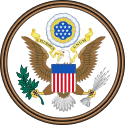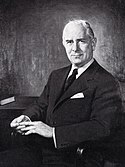Handelsministerium der Vereinigten Staaten
| Handelsministerium der Vereinigten Staaten | |
|---|---|
| Eingerichtet: | 14. Februar 1903 |
| Sitz: | Herbert C. Hoover Building, Washington, D.C. |
| Aufsichtsbehörde: | |
| Minister | Gina M. Raimondo |
| Stellvertreter | Wynn Coggins |
| Haushalt: | 7,9 Mrd. (2021)[1] $ |
| Angestellte: | 46.608 (2018)[2] |
| Homepage: | commerce.gov |
Das Handelsministerium der Vereinigten Staaten (englisch United States Department of Commerce, DOC) ist Teil der Bundesregierung und kümmert sich um die Belange der Wirtschaft – mit dem Ziel, deren Wachstum zu fördern. Die Behörde wurde am 14. Februar 1903 ursprünglich als Ministerium für Handel und Arbeit gegründet. Im Jahre 1913 wurde der Bereich „Arbeit“ jedoch in das heute selbständige Arbeitsministerium ausgegliedert.

Organisation
Der Auftrag des Handelsministeriums ist die Schaffung von Arbeitsplätzen sowie die Sicherung des Lebensstandards für alle Bürger der Vereinigten Staaten durch Aufbau der notwendigen Infrastruktur. Auf dieser Basis soll ökonomischer Wachstum, Wettbewerbsfähigkeit und eine dauerhaft positive Entwicklung sichergestellt werden. Hierzu sammelt die Behörde ökonomische und demografische Daten durch das Amt für Volkszählung, um wirtschaftliche und politische Entscheidungen zu ermöglichen. Das Handelsministerium vergibt Patente, die Rechte für Trademarks (Schutzmarken) und hilft bei der Umsetzung sowie Einführung von Industriestandards (Norm).
Rund 36.000 Mitarbeiter sind für die Behörde tätig, welche vom United States Secretary of Commerce, dem Handelsminister, geleitet wird. Sitz der Behörde ist das Herbert C. Hoover Building, ein Verwaltungsgebäude im Federal Triangle nur wenige Meter vom Weißen Haus entfernt.
Ministersituation 2011–2013
Nachdem John Bryson sein Amt des Handelsministers im Juni 2012 niedergelegt hatte, war das Handelsministerium in der Schwebe. Von Juni 2012 bis Ende Mai 2013 leitete die unter Bryson stellvertretende Handelsministerin Rebecca Blank das Ressort kommissarisch als sog. Acting Secretary of Commerce weiter. Am 2. Mai 2013 wurde die Hyatt-Erbin Penny Pritzker von Präsident Barack Obama als neue Handelsministerin nominiert.[3]
Da Rebecca Blank am 31. Mai Kanzlerin der Universität von Wisconsin-Madison wurde und der Senat die Nominierung Pritzkers noch nicht bestätigt hatte, fand Präsident Obama in Cameron Kerry, dem Bruder von US-Außenminister John Kerry, eine zwischenzeitliche Lösung. Kerry leitete vom 1. bis zum 25. Juni das Handelsministerium – erneut nur kommissarisch.[4]
Am 25. Juni 2013 bestätigte der US-Senat Pritzkers Nominierung als Handelsministerin mit 97:1 Stimmen. Am darauffolgenden Tag, dem 26. Juni, wurde der neuen Ministerin der Amtseid abgenommen.[5] Cameron Kerry nahm den Posten des General Counsel im Handelsministerium an.[6]
Unterstellte Behörden

- Bureau of Industry and Security (BIS)
- Economics and Statistics Administration (ESA)
- • Bureau of Economic Analysis (BEA)
- • Bureau of the Census
- Economic Development Administration (EDA)
- International Trade Administration (ITA)
- Minority Business Development Agency (MBDA)
- National Oceanic and Atmospheric Administration (NOAA)
- National Telecommunications and Information Administration (NTIA)
- Patent and Trademark Office (PTO)
- Technology Administration (TA)
- • National Institute of Standards and Technology (NIST)
- • National Technical Information Service (NTIS)
- • Office of Technology Policy (OTP)
- • National Technical Information Service (NTIS)
Liste der Handelsminister
| Nr. | Bild | Name | Amtszeit | unter Präsident |
|---|---|---|---|---|
| 1 |  | William Cox Redfield | 5. März 1913–31. Oktober 1919 | Woodrow Wilson |
| 2 |  | Joshua Willis Alexander | 16. Dezember 1919–4. März 1921 | |
| 3 | Herbert Clark Hoover | 5. März 1921–21. August 1928 | Warren G. Harding, Calvin Coolidge | |
| 4 |  | William Fairfield Whiting | 22. August 1928–4. März 1929 | Calvin Coolidge |
| 5 |  | Robert Patterson Lamont | 5. März 1929–7. August 1932 | Herbert Hoover |
| 6 |  | Roy Dikeman Chapin | 8. August 1932–3. März 1933 | |
| 7 |  | Daniel Calhoun Roper | 4. März 1933–23. Dezember 1938 | Franklin D. Roosevelt |
| 8 |  | Harry Lloyd Hopkins | 24. Dezember 1938–18. September 1940 | |
| 9 |  | Jesse Holman Jones | 19. September 1940–1. März 1945 | |
| 10 |  | Henry Agard Wallace | 2. März 1945–20. September 1946 | Franklin D. Roosevelt, Harry S. Truman |
| 11 |  | William Averell Harriman | 7. Oktober 1946–22. April 1948 | Harry S. Truman |
| 12 |  | Charles W. Sawyer | 6. Mai 1948–20. Januar 1953 | |
| 13 |  | Charles Sinclair Weeks | 21. Januar 1953–10. November 1958 | Dwight D. Eisenhower |
| - |  | Lewis Lichtenstein Strauss | 1958–1959 (kommissarisch) | |
| 14 |  | Frederick Henry Mueller | 10. August 1959–19. Januar 1961 | |
| 15 |  | Luther Hartwell Hodges | 21. Januar 1961–15. Januar 1965 | John F. Kennedy, Lyndon B. Johnson |
| 16 |  | John Thomas Connor | 18. Januar 1965–31. Januar 1967 | Lyndon B. Johnson |
| 17 |  | Alexander Buel Trowbridge | 14. Juni 1967–1. März 1968 | |
| 18 |  | Cyrus Rowlett Smith | 6. März 1968–19. Januar 1969 | |
| 19 |  | Maurice Hubert Stans | 21. Januar 1969–15. Februar 1972 | Richard Nixon |
| 20 |  | Peter George Peterson | 29. Februar 1972–1. Februar 1973 | |
| 21 |  | Frederick Baily Dent | 2. Februar 1973–26. März 1975 | Richard Nixon, Gerald Ford |
| 22 |  | Rogers Clark Ballard Morton | 1. Mai 1975–2. Februar 1976 | Gerald Ford |
| 23 |  | Elliot Lee Richardson | 2. Februar 1976–20. Januar 1977 | |
| 24 |  | Juanita Morris Kreps | 23. Januar 1977–31. Oktober 1979 | Jimmy Carter |
| 25 |  | Philip Morris Klutznick | 9. Januar 1980–19. Januar 1981 | |
| 26 |  | Howard Malcolm Baldrige | 20. Januar 1981–25. Juli 1987 | Ronald Reagan |
| 27 |  | Calvin William Verity | 19. Oktober 1987–30. Januar 1989 | |
| 28 |  | Robert Adam Mosbacher | 31. Januar 1989–15. Januar 1992 | George Bush |
| 29 |  | Barbara Hackman Franklin | 27. Februar 1992–20. Januar 1993 | |
| 30 |  | Ronald Harmon Brown | 22. Januar 1993–3. April 1996 | Bill Clinton |
| 31 |  | Michael Kantor | 12. April 1996–21. Januar 1997 | |
| 32 |  | William Michael Daley | 30. Januar 1997–19. Juli 2000 | |
| 33 |  | Norman Yoshio Mineta | 21. Juli 2000–19. Januar 2001 | |
| 34 |  | Donald Louis Evans | 20. Januar 2001–7. Februar 2005 | George W. Bush |
| 35 |  | Carlos Miguel Gutierrez | 7. Februar 2005–20. Januar 2009 | |
| 36 |  | Gary Faye Locke | 24. März 2009–1. August 2011 | Barack Obama |
| 37 |  | John E. Bryson | 21. Oktober 2011–21. Juni 2012 | |
| 38 |  | Penny Sue Pritzker | 26. Juni 2013–20. Januar 2017 | |
| 39 |  | Wilbur Louis Ross Jr. | 28. Februar 2017–20. Januar 2021 | Donald Trump |
| 40 |  | Gina Raimondo[7] | seit dem 3. März 2021 | Joe Biden |
Siehe auch
Weblinks
- Offizielle Website (englisch)
Einzelnachweise
- ↑ Budget and performance. U.S. Department of Commerce, abgerufen am 5. Februar 2021 (englisch).
- ↑ About Commerce. U.S. Department of Commerce, abgerufen am 5. Februar 2021 (englisch).
- ↑ Cameron Kerry kommissarischer Handelsminister: John Kerrys Bruder kommt ins Kabinett. In: n-tv.de. 14. Mai 2013, abgerufen am 20. Juli 2018.
- ↑ Nikolaus Piper: Von Obama nachträglich belohnt. In: sueddeutsche.de. 2. Mai 2013, abgerufen am 9. März 2018.
- ↑ Swearing-In Ceremony of Ms. Penny Pritzker as the 38th U.S. Secretary of Commerce. U.S. Department of Commerce, 26. Juni 2013, abgerufen am 20. Juli 2018 (englisch, Video auf YouTube, 18:31 Minuten).
- ↑ Commerce Leadership. U.S. Department of Commerce, archiviert vom (nicht mehr online verfügbar) am 16. März 2015; abgerufen am 9. März 2018 (englisch). Info: Der Archivlink wurde automatisch eingesetzt und noch nicht geprüft. Bitte prüfe Original- und Archivlink gemäß Anleitung und entferne dann diesen Hinweis.
- ↑ Katherine Gregg: From governor to Cabinet: Raimondo is sworn in as commerce secretary. Abgerufen am 4. März 2021 (amerikanisches Englisch).
Auf dieser Seite verwendete Medien
Penny Pritzker, United States Secretary of Commerce.
ESSA B-57 Canberra, registration N1005, in flight , U.S. Department of Commerce
Autor/Urheber: Kenneth C. Zirkel, Lizenz: CC BY-SA 3.0
Rhode Island Governor Gina Raimondo speaks at the ribbon-cutting ceremony for the new Providence Pedestrian Bridge.
Michael "Mickey" Kantor, U.S. Secretary of Commerce
Jesse Holman Jones
William C. Redfield
A photo of former Commerce Secretary William Daley (1997-2000)
Official portrait of Department of Commerce Secretary Wilbur Ross
Barbara Hackman Franklin, U. S. Secretary of Commerce Source: NOAA Photo Library
Herbert Clark Hoover
Seal of the United States Department of Commerce.
The seal was approved on April 4, 1913 and is derived from the seal of the defunct United States Department of Commerce and Labor. It is composed of the arms (Per fesse azure and or, a ship in full sail on waves of the sea, in chief proper; and in base a lighthouse illumined proper), and crest ("The American Eagle displayed"). Around the arms, between two concentric circles, are the words "Department of Commerce" and "United States of America".
The official symbolism has been modified as the functions of the department have changed. As of 2007: the ship is a symbol of commerce; the blue denotes uprightness and constancy; the lighthouse is a well-known symbol representing guidance from the darkness which is translated to commercial enlightenment; and the gold denotes purity. The crest is the American bald eagle denoting the national scope of the Department's activities.
Full description at CFR Title 15 Part 1en:Harry Lloyd Hopkins, en:Secretary of Commerce, National Oceanic and Atmospheric Administration/Department of Commerce
Credit: National Oceanic and Atmospheric Administration/Department of Commerce [1] Malcolm Baldrige, Secretary of Commerce
Transwiki approved by: w:en:User:Dmcdevit This image was copied from wikipedia:en. The original description was: Philip Morris Klutznick, U.S. Secretary of Commerce
Calvin William Verity Jr., U.S. Secretary of Commerce
Official portrait of United States Secretary of Commerce John Bryson.
United States Department of Commerce building in Washington, D.C.
Rogers Morton, former Secretary of the Interior and Secretary of Commerce of the United States.
Norman Yoshio Mineta, U.S. Secretary of Commerce and Transportation.
Credit: National Oceanic and Atmospheric Administration/Department of Commerce [1]
en:Frederick Henry Mueller, en:Secretary of Commerce















































